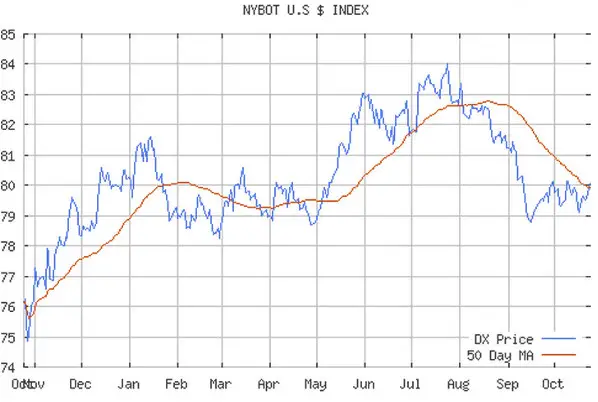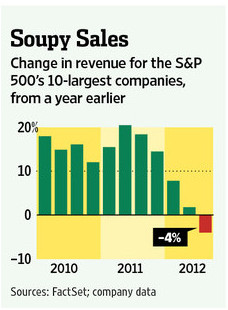Courtesy of John Rubino.
The Eurozone meltdown has sent capital pouring into (temporarily) safe haven currencies like the US dollar, which rose by nearly 12% between October 2011 and August 2012.
This sounds like a good thing for the US but it’s not, because US multinationals lose big when the dollar pops. Assume, for example, that you’re making computers in California and selling them to Germany, and the dollar goes up by 10%. Suddenly your computers are 10% more expensive, which makes it hard to sell as many as you expected. And those that you do sell are paid for with euros, which are now worth 10% less than they were a few months ago. When you convert those euros to dollars in order to pay your bills, your revenues are 10% lower than they should be. Your costs, meanwhile, are mostly in dollars, so your profit ends up being far lower than you expected.
Now combine this margin squeeze with an order slowdown in Europe and China, and extend it to the whole S&P 500 and you get the following:
Firings Reach Highest Since 2010 as Ford to Dow Face Sales Slump
Ford Motor Co. (F) and Dow Chemical Co. (DOW) joined a growing number of companies firing thousands of workers as sluggish U.S. growth and Europe’s deepening recession lead to a persisting slump in sales.
North American companies have announced plans to eliminate 62,600 positions at home and abroad since Sept. 1, the biggest two-month drop since the start of 2010, according to data compiled by Bloomberg. Firings total 158,100 so far this year, more than the 129,000 job cuts in the same period in 2011.
Falling corporate profits and mass layoffs combine to lower federal tax revenues, which puts pressure on Washington to fix its strong dollar problem. As yesterday’s Wall Street Journal explained it:
Some Hard Numbers for the Fed to Focus On
Wags in the market were quick to label the Federal Reserve’s latest open-ended stimulus effort “QEternity,” but all things have to end. Trillions of dollars are riding on when that may be.
If the Fed is taken at its word, it will err on the side of caution before winding down its bond-buying program and will keep interest rates near zero until mid-2015. Traders who track bets on interest-rate futures and swaps say the market began to call the Fed’s bluff last week, implying an earlier, late 2014 tightening of policy.
Instead of when, Wednesday’s statement following the Fed’s latest two-day meeting may shift the dialogue to what it would like to see happening before taking its foot off the gas.
Charles Evans, president of the Federal Reserve Bank of Chicago, said recently that there should be no change as long as unemployment stays above 7% and inflation below 3%.
That presents another problem, though: The market takes official statistics with a grain of salt, and so should the Fed. For example, the unemployment rate fell in two months to 7.8% from 8.3%.
“How can you have an explicit target over data that’s so soft and subject to revision?” asks Jim Vogel, interest-rate strategist at FTN Financial.
Conspiracy theories by former General Electric Co. chief Jack Welch aside, any number of official indicators can look very different well after their initial release. But one number almost never subject to revision is corporate revenue.
That is painting a scary picture, in contrast to a string of positive surprises recently in economic data. Since peaking at more than 20% in the second quarter of 2011, year-on-year growth in collective sales for the 10-largest companies in the S&P 500 has been sliding. Last quarter, it went negative for the first time since the recession, based on preliminary figures, falling by 4%. If not for Apple Inc., the drop would be 6.5%.
More broadly, 63% of S&P 500 companies that have so far reported third-quarter results have missed revenue forecasts, Thomson Reuters says.
Some thoughts
Can an economy grow if its biggest corporations are shrinking? Maybe, but it would take one hell of a housing boom along with a resumption of public sector hiring, neither of which actually make a society richer. A home eats rather than builds capital, no matter what your realtor tells you. And government spending is almost never “investment”. So replacing business profits with personal and public consumption would raise reported GDP but in reality would make us poorer and more indebted, setting the stage for a bigger crisis down the road.
So the dollar has to fall, thus shifting the strong currency burden to our trading partners. Quantitative easing, of course, is designed partly as a currency war weapon. But we’ve already fired that gun for three years: Federal debt is rising by about $1.5 trillion a year, bank reserves are soaring, historically low mortgage rates have produced a tsunami of refis…and it’s not working. The dollar, though off a bit this month, remains too high for corporate comfort.
But QE is pretty much all that’s left, unless you count capital controls, which are generally a disaster for multinational profits, and mass debt liquidation, which is another word for capital “d” depression. So the next administration will be left with no alternative but more of the same on an even bigger scale. If $10 trillion doesn’t do it, we’ll try $20 trillion.
This is crazy of course. But when you’re staring into the abyss, crazy becomes a relative concept.
Visit John’s Dollar Collapse blog here >





